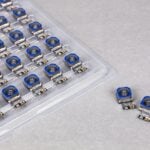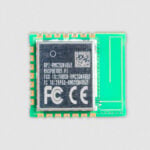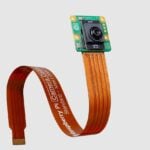A new 5″ variant of Raspberry Pi Touch Display 2
Last year we launched the refreshed 7″ Raspberry Pi Touch Display 2 as a successor to our original 2015 Touch Display, offering a simplified form factor and higher 720×1280-pixel resolution at the same $60 price point. Today we’re excited to announce a new 5″ variant, available to buy now from Raspberry Pi Approved Resellers. It shares the same resolution and easy setup as the 7″ variant, at the low price of $40.

Key features
Except for its size, the specification of the new 5″ variant is almost identical to that of its bigger sibling:
- 5″ diagonal display
- 62mm × 110mm active area
- 720 (RGB) × 1280 pixels
- True multi-touch capacitive panel, supporting five-finger touch
- Fully supported by Raspberry Pi OS
- Powered from the host Raspberry Pi
- All necessary cables, connectors, and mounting hardware included
A plug-and-play multi-touch display
What makes Raspberry Pi Touch Display 2 particularly appealing is its seamless integration with the rest of the Raspberry Pi product ecosystem.
Its capacitive touch screen works out of the box with full Linux driver support – no manual calibration required, no hunting through device trees, and no wrestling with incompatible touch controllers. Connect it to your Raspberry Pi (our installation guide shows you how, including connecting to the Raspberry Pi’s standard 5V GPIO supply for power), and you have a fully functional multi-touch display that just works. Now you can concentrate on your project instead of hardware hassles.

To illustrate our new 5″ display’s capabilities, I decided to create a simple slideshow application using AI-assisted development. This seemed like a perfect opportunity to explore and demonstrate both the hardware’s multi-touch features and modern development workflows.
Developing code with AI
Not everyone thinks AI is the future of software engineering, but I find it important to understand how technology advances, so this year I’ve been dipping my hand into coding with AI. To give you an idea of how easy this is, I thought I’d share all the prompts I gave to Cursor (using the Claude Sonnet 4 model) to develop a very simple slideshow application for the 5″ variant of Raspberry Pi Touch Display 2.
You can see the prompts I used to drive the model in the italicised text below. After each prompt or set of prompts, I’ve included some notes about why I used them and how effective they were at getting me closer to the result I wanted.
A brief for a touch display slideshow application
I began by giving the AI a high-level, but quite specific, brief:
I would like to create a simple application running on the Raspberry Pi remote device which has a touch panel attached. The application should display images from a local directory as a slideshow. Touching the display should stop the slideshow and allow the user to manipulate the position and be able to zoom in using standard gestures
This gave a working and usable application, but zooming and panning didn’t work. It seemed only to support a single touch. This is because of some of the choices made by the compositor to convert touches into mouse click or doubleclick events (the compositor does this so the touchscreen works with the UI correctly).
Capturing touch events
- Two finger zoom doesn’t work, does the application use the multi-touch interface to handle zoom gestures?
- The “touches” in the top left are always zero, even though there are multiple cursors on the screen with multiple touches
- The raw test is detecting two presses when there is only one
The AI suggested parsing the touch events from the raw input device, but it was incorrectly parsing both the multi-touch events and the mouse events generated by the driver. Once fixed, it was working well, but it wasn’t taking into consideration the display rotation from landscape to portrait.
- The display is a portrait display, but it is being rotated. So the coordinates need to be adjusted
- You should use kmsprint on a modern device
- Both axes are inverted, can you reverse the direction?
- That is not working correctly, how about you put some boxes on the screen and I’ll tap them so you can identify the correct mapping
Cursor first of all tried to use xrandr to get the screen resolution, so I had to tell it to use kmsprint instead. Then it got things working, but the orientations of the x and y axes were incorrect. I suggested it create a calibration test application to identify the translation of coordinates.
Translating coordinates
- Can you just display one box at a time for me to press so you can confirm the correctness of the raw touch positions for a single touch. Then repeat with two boxes for two finger touch?
- That is correct left-right although the box doesn’t go past around 700
- No that’s still not working. How about you place a box into each corner of the screen one at a time and I’ll click them. From that you should have all the information to translate a single finger touch event
- The top right box is not in the top right, it’s closer to middle top… Does your code correctly get the screen size
This was a relatively long trial-and-error process, in which it was important to advise the AI to approach this in the right way. I asked it to put four boxes onto the screen successively and I’d click them, and then from those values the AI should be able to calculate the translation correctly. It also had some trouble with the maximum and minimum widths and heights.
Keeping the AI on task
Great, that works correctly, can you extract the code and make a library from it?
This is an important point: in real software engineering, when we get something like this working it’s important to extract its functionality and create a library for it, so the functionality can be shared with other applications. AI generally doesn’t do this very well and will keep editing a single long piece of code, which can get edited and modified without you asking as it hallucinates random changes for no apparent reason. By extracting the code into a separate library (which has some test functionality), we can make sure the AI is focused on the application.
- I think the code is getting confused between panning and zooming the images. It looks like when trying to pan it’s also zooming as well.
- The problem is that the zoom is being significantly over estimated, there should be a 1:1 ratio of the size of the zoom to the size of the change in the two touch points
- To test the zoom, can you temporarily disable panning so I can just zoom an image
- Ok, that is working, but the center of the image is changing with the zoom
- The zoom now works correctly, can you re-enable the panning but track both pan and zoom at the same time.
The problem here is that the zoom was being altered for every touch event received, so it wasn’t a linear pinch or zoom. The AI worked out what the problem was independently of my input – I just made sure it was working on one thing at a time.

Tidying up
- Please remove any reference to key processing or mouse processing. This is only touch controlled.
- Please remove any debug or logging print calls
These are final clean-up steps. I went through the code it had generated to see if there was a lot of cruft that wasn’t needed.
Running the touchscreen slideshow code yourself
If you’d like to try running the code yourself, or if you’d like to reuse and improve the multi-touch library, you can do the following:
git clone https://github.com/ghollingworth/slideshow
cd slideshow
./run.sh
Coding with AI: Advantages, limitations
Here, it’s taken me just a couple of hours to generate an application that I couldn’t otherwise have produced nearly as quickly. However, I still don’t know how the application is architected, if I wanted to add some functionality I’m not sure I’d know where to start, and I’m not convinced the application is complete or bug-free!
For some applications, using AI to generate code is really useful and can speed up software development significantly; writing test applications or development systems are two examples of where it can be very helpful. But it’s critical to be aware of the limitations of this approach. At Raspberry Pi we’re taking a strictly targeted and heavily supervised approach, using these new tools only on test software and build scripts, and reviewing their output very carefully.
Build cool stuff with the new 5″ Raspberry Pi Touch Display 2
I hope my quick demo has given you an idea of how easy it can be to develop interactive applications with our multi-touch displays. Touch Display 2 offers a straightforward way to integrate a high-quality user interface into countless applications, whether those are personal builds, research projects, or commercial solutions, and our new 5″ variant provides an even more compact option if you’re targeting the smallest form factors.
Both 5″ and 7″ variants of Raspberry Pi Touch Display 2 are available to buy now from our worldwide network of Approved Resellers. As ever, we’ll enjoy seeing what you do with it.






25 comments
Jump to the comment form
Ryan P Grainger
Cool stuff, looking forward to be able to use this to cram more features into a smaller space.
aBUGsworstnightmare
Been waiting for that for quite a while now. Viewing angle spec is shown as 85deg -> what is the display technology; is it IPS?
Raspberry Pi Staff Gordon Hollingworth — post author
Yes it is IPS
Gordon77
Looks good, and a good price..
Mickael
Awesome, it should be perfect for my handheld gaming project without changing CSS code. Of course it can be used in landscape mode ?
Raspberry Pi Staff Gordon Hollingworth — post author
Yes, the operating system can be set up to rotate the display easily enough, just open the “Screen Configuration” application from the “Preferences” menu. Right click the display and change “Orientation”
Michael Horne
Is the setting “sticky” or does it need doing each time? Any way to do it without the desktop?
Andrew S
Yes and yes :-)
See the documentation https://www.raspberrypi.com/documentation/accessories/touch-display-2.html#change-screen-orientation
Christian Celona
In my opinion, the graphical interface of the operating system is unusable with such small screens. I don’t think it depends only on my venerable age.
Anders
I don’t think it is intended as a screen for a desktop system.
Raspberry Pi Staff Gordon Hollingworth — post author
Yes, that’s correct which is why I demonstrate how to develop an application specifically for the touchscreen.
The only operating systems developed to work with touchscreens are Android and iOS. Anything else doesn’t really work properly and Raspberry Pi OS is no exception, the UI toolkits (GTK, Qt, etc.) were not written from the ground-up to support touch and therefore it is a bit of a cludgy hack…
Anders
Android and its derivatives, iOS and Sailfish OS, Tizen etc
Roger
So if three vendors, one selling at $40 is sold out, and the other two are selling it for $50 and $58. No, uh uh.
Raspberry Pi Staff Ashley Whittaker
Could you let us know which vendors you’re looking at?
Those prices may automatically include local taxes/shipping but we’d still like to check.
Glen
Both CanaKit and PiShop have it listed for $50.95 + sales tax + shipping charges. 25% above MSRP is pretty high.
tim Rowledge
I think you are seeing the effects of Trump Tariffs here. The price in Canadian dollars shows as C$55, which is a sensible seeming conversion from not-Trump-Tariff pricing.
Daniel Blint
List price: $40
American retailers (all listed): Jacked up price + tax + shipping = $60-$70.
UK tariff is currently 10%, so that’s $40 + $4 (are tariffs on the list price or wholesale price?), but all the firms listed are charging $50.95 + tax + shipping or $53.95 + tax.
How do I become a certified Raspberry Pi Dealer?
Stavros
Finallyyyy
Nicko
This is great, but my one complaint about both this new display and the 7″ display is the size of the bezel around the edge. Both displays have more than 30mm of dead space around the edge in both directions; the visible area of the 7″ display very nearly fits into the full size of the 5″ display.
I appreciate that you’ll not be creating another display product for a little while, but next time you do, any chance that you could give us a display with less bezel and more usable screen frontage?
Raspberry Pi Staff Gordon Hollingworth — post author
Our original choice to have a larger bezel (ten years ago!) was because we saw it mostly being used in home maker projects where you can take an off-the-shelf box, hand cut a hole in it and glue the panel into the hole.
But will keep in mind for any future refresh…
Anders
A user removable bezel might serve both use cases.
Jan
Great product, I have directly plenty of ideas. Are there any 3D data available? I will need some housing for it to build a wallpanel :-)
Andrew S
Yes, see the Product Brief :-)
https://datasheets.raspberrypi.com/display/touch-display-2-product-brief.pdf
David
A fantastic addition to your product line-up. Will have good uses for this, thank you. However, could you please, please, please consider producing a 10″ version? The 7″ is great (I have four of them), but they’re just a bit small for say wall control panels (for HA, or other, I currently use old tablets, etc). Your 15″ is also great, but not touchscreen. Or are there a technical limitation to the DSI channel? Thanks.
PojavlauncherDL
Looks great — the 5″ size makes it much more versatile for compact builds.